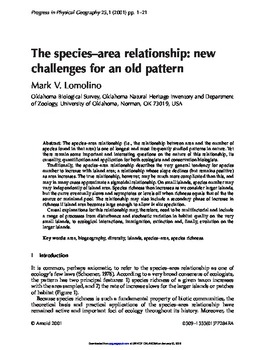| dc.contributor.author | Mark V. Lomolino | |
| dc.date.accessioned | 2016-01-14T19:53:10Z | |
| dc.date.accessioned | 2016-03-30T15:36:28Z | |
| dc.date.available | 2016-01-14T19:53:10Z | |
| dc.date.available | 2016-03-30T15:36:28Z | |
| dc.date.issued | 2001-03-01 | |
| dc.identifier.citation | Lomolino, M. V. (2001). The species-area relationship: new challenges for an old pattern. Progress in Physical Geography, 25(1), 1-21. doi: 10.1177/030913330102500101 | en_US |
| dc.identifier.uri | https://hdl.handle.net/11244/25103 | |
| dc.description.abstract | The species-area relationship (i.e., the relationship between area and the number of species found in that area) is one of longest and most frequently studied patterns in nature. Yet there remain some important and interesting questions on the nature of this relationship, its causality, quantification and application for both ecologists and conservation biologists. | en_US |
| dc.language.iso | en_US | en_US |
| dc.publisher | Progress in Physical Geography | |
| dc.subject | area | en_US |
| dc.subject | biogeography | en_US |
| dc.subject | diversity | en_US |
| dc.subject | islands | en_US |
| dc.subject | species-area | en_US |
| dc.subject | species richness | en_US |
| dc.title | The species-area relationship: new challenges for an old pattern | en_US |
| dc.type | Research Article | en_US |
| dc.description.peerreview | Yes | en_US |
| dc.description.peerreviewnotes | https://us.sagepub.com/en-us/nam/manuscript-submission-guidelines | en_US |
| dc.identifier.doi | 10.1177/030913330102500101 | en_US |
| dc.rights.requestable | false | en_US |
